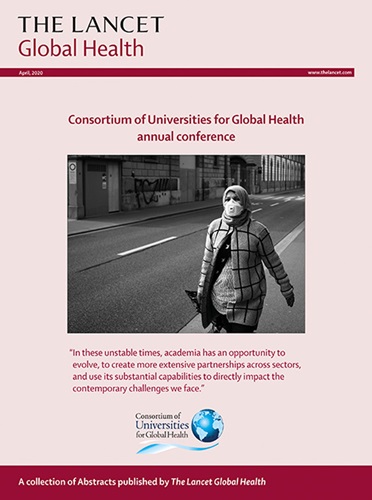Delivery effectiveness of and adherence to intermittent preventive treatment for malaria in pregnancy with dihydroartemisinin-piperaquine with or without targeted information transfer or sulfadoxine-pyrimethamine in western Kenya: a three-armed, pragmatic, open-label, cluster-randomised trial.
IF 19.9
1区 医学
Q1 PUBLIC, ENVIRONMENTAL & OCCUPATIONAL HEALTH
引用次数: 0
Abstract
BACKGROUND High-level resistance to sulfadoxine-pyrimethamine threatens the efficacy of WHO-recommended intermittent preventive treatment in pregnancy (IPTp) with single-dose sulfadoxine-pyrimethamine to prevent malaria. Monthly IPTp with dihydroartemisinin-piperaquine, a 3-day regimen, is an emerging alternative, but this regimen poses potential implementation and adherence challenges. We aimed to assess adherence to a multiday IPTp with dihydroartemisinin-piperaquine regimen and its delivery effectiveness in routine antenatal care settings in western Kenya. METHODS We conducted a pragmatic, three-armed, open-label, cluster-randomised trial in antenatal clinics in 18 health-care facilities (six facilities per group) in Kisumu County and Homa Bay County in western Kenya. Clusters were facilities offering routine antenatal care services provided by trained Ministry of Health staff with 100 or more antenatal clinic attendances per month between July, 2018, and June, 2019. Private or mission hospitals, dispensaries, referral hospitals, and trial sites were excluded. Individuals in their first trimester, living with HIV, or who were not attending a scheduled antenatal clinic visit were excluded. The 18 antenatal clinics were grouped into matched triplets stratified by location and clinics in each matched triplet were randomly assigned to one of the three study groups (1:1:1). Masking was not possible. Two groups were given IPTp with dihydroartemisinin-piperaquine (one group with a targeted information transfer intervention and one group without any additional interventions) and one group was given the standard of care (ie, IPTp with sulfadoxine-pyrimethamine). The primary endpoint, adherence, was defined as the proportion of participants completing their most recent 3-day IPTp with dihydroartemisinin-piperaquine regimen. This completion was verified by pill counts during home visits no more than 2 days after participants' 3-day regimens ended. The secondary endpoint, delivery effectiveness, was defined as the proportion of participants who received the correct number of IPTp tablets and correctly repeated dosing instructions (ie, correctly recalled the instructions they received about self-administered dihydroartemisinin-piperaquine doses and the number of sulfadoxine-pyrimethamine tablets they had received) at their exit from the antenatal clinic. Individuals receiving treatment for malaria, visiting a clinic for registration only, or interviewed during IPTp drug stock-outs were excluded from analyses. We used generalised linear mixed models to compare endpoints among the IPTp with dihydroartemisinin-piperaquine groups. This trial was registered with ClinicalTrials.gov, NCT04160026, and is complete. FINDINGS 15 facilities (five per group) completed the trial, with 1189 participants having exit interviews (377 in the IPTp with sulfadoxine-pyrimethamine group, 408 in the IPTp with dihydroartemisinin-piperaquine only group, and 404 in the IPTp with dihydroartemisinin-piperaquine plus targeted information transfer intervention group) and 586 participants having home visits (267 in the IPTp with dihydroartemisinin-piperaquine only group and 319 in the IPTp with dihydroartemisinin-piperaquine plus targeted information transfer intervention group) from Sept 8 to Dec 10, 2020. Relative to the IPTp with dihydroartemisinin-piperaquine only group, adherence was 16% higher in the IPTp with dihydroartemisinin-piperaquine plus targeted information transfer intervention group (266 [83%] of 319 participants vs 196 [73%] of 267 participants; adjusted relative risk [RR] 1·16, 95% CI 1·03-1·31; p=0·0140). Delivery effectiveness in the IPTp with dihydroartemisinin-piperaquine plus targeted information transfer intervention group was not significantly different from that in the IPTp with sulfadoxine-pyrimethamine group (352 [87%] of 403 participants vs 335 [89%] of 375 participants; adjusted RR 0·97, 95% CI 0·90-1·05; p=0·4810). However, delivery effectiveness in the IPTp with dihydroartemisinin-piperaquine only group was significantly lower than in the IPTp with sulfadoxine-pyrimethamine group (300 [74%] of 404 participants vs 335 [89%] of 375 participants; 0·84, 0·75-0·95; p=0·0030). INTERPRETATION Targeted information transfer interventions to health-care providers and pregnant individuals boost antenatal care delivery adherence to a multiday regimen with dihydroartemisinin-piperaquine. FUNDING European and Developing Countries Clinical Trials Partnership 2, UK Joint Global Health Trials Scheme of the Foreign, Commonwealth and Development Office, Medical Research Council, National Institute for Health and Care Research, and Wellcome Trust; and Swedish International Development Cooperation Agency.在肯尼亚西部使用双氢青蒿素-哌喹联合或不联合定向信息传递或磺胺多辛-乙胺嘧啶对妊娠期疟疾进行间歇性预防治疗的分娩效果和依从性:一项三臂、务实、开放标签、分组随机试验。
背景世界卫生组织建议使用单剂量磺胺乙胺嘧啶进行妊娠间歇预防性治疗(IPTp)以预防疟疾,但磺胺乙胺嘧啶的高水平抗药性威胁着这种治疗方法的疗效。使用双氢青蒿素-哌喹的每月IPTp(一种为期3天的治疗方案)是一种新兴的替代方案,但这种治疗方案在实施和依从性方面存在潜在挑战。我们在肯尼亚西部基苏木县和霍马湾县的 18 家医疗机构(每组 6 家医疗机构)的产前门诊开展了一项务实、三臂、开放标签、分组随机试验。群组是指在2018年7月至2019年6月期间,由经过培训的卫生部工作人员提供常规产前护理服务的医疗机构,每月产前门诊就诊人次达到或超过100人次。私立医院或传教士医院、药房、转诊医院和试验点不包括在内。不包括怀孕头三个月的孕妇、艾滋病感染者或没有按时到产前检查诊所就诊的人。按地点将 18 家产前诊所分成匹配的三组,并将每个匹配的三组中的诊所随机分配到三个研究组中的一组(1:1:1)。无法进行掩蔽。两组接受双氢青蒿素-哌喹的IPTp治疗(一组接受有针对性的信息传递干预,另一组不接受任何额外干预),一组接受标准治疗(即使用磺胺乙胺嘧啶的IPTp治疗)。主要终点(坚持治疗)被定义为完成最近 3 天使用双氢青蒿素-哌喹的 IPTp 治疗方案的参与者比例。在参与者结束 3 天疗程后不超过 2 天的家访中,通过药片计数来核实完成情况。次要终点(分娩效果)是指参与者在离开产前检查诊所时收到正确数量的IPTp药片并正确重复用药说明(即正确回忆起他们收到的关于自服双氢青蒿素-哌喹剂量的说明以及他们收到的磺胺多辛-嘧啶药片数量)的比例。正在接受疟疾治疗、仅到诊所进行登记或在 IPTp 药物缺货期间接受采访的个人不在分析之列。我们使用广义线性混合模型比较了IPTp组和双氢青蒿素-哌喹组的终点。该试验已在 ClinicalTrials.gov 登记,编号为 NCT04160026,现已完成。15 家机构(每组 5 家)完成了试验,对 1189 名参与者进行了退出访谈(使用磺胺乙胺嘧啶的 IPTp 组有 377 人,仅使用双氢青蒿素-哌喹的 IPTp 组有 408 人,使用磺胺乙胺嘧啶-哌喹的 IPTp 组有 404 人)、2020年9月8日至12月10日,586名参与者进行了家访(仅使用双氢青蒿素-哌喹的IPTp组为267人,使用双氢青蒿素-哌喹的IPTp加有针对性的信息传递干预组为319人)。与仅使用双氢青蒿素-哌喹的IPTp组相比,使用双氢青蒿素-哌喹的IPTp加有针对性的信息传递干预组的坚持率高16%(319名参与者中的266人[83%]vs 267名参与者中的196人[73%];调整后相对风险[RR]1-16,95% CI 1-03-1-31;P=0-0140)。使用双氢青蒿素-哌喹加目标信息传递的 IPTp 干预组与使用磺胺乙胺嘧啶的 IPTp 干预组的给药效果无显著差异(403 名参与者中的 352 [87%] vs 375 名参与者中的 335 [89%];调整后 RR 0-97,95% CI 0-90-1-05;p=0-4810)。然而,仅使用双氢青蒿素-哌喹的 IPTp 组的给药效果明显低于使用磺胺乙胺嘧啶的 IPTp 组(404 名参与者中的 300 [74%] 对 375 名参与者中的 335 [89%];0-84,0-75-0-95;p=0-0030)。解释向医疗服务提供者和孕妇进行有针对性的信息传递干预,可促进产前护理分娩时坚持使用双氢青蒿素-哌喹多日疗法。资金来源欧洲和发展中国家临床试验伙伴关系 2、英国外交、联邦和发展办公室联合全球健康试验计划、医学研究委员会、国家健康和护理研究所以及威康信托基金;以及瑞典国际发展合作署。
本文章由计算机程序翻译,如有差异,请以英文原文为准。
求助全文
约1分钟内获得全文
求助全文
来源期刊

Lancet Global Health
PUBLIC, ENVIRONMENTAL & OCCUPATIONAL HEALTH-
CiteScore
44.10
自引率
1.20%
发文量
763
审稿时长
10 weeks
期刊介绍:
The Lancet Global Health is an online publication that releases monthly open access (subscription-free) issues.Each issue includes original research, commentary, and correspondence.In addition to this, the publication also provides regular blog posts.
The main focus of The Lancet Global Health is on disadvantaged populations, which can include both entire economic regions and marginalized groups within prosperous nations.The publication prefers to cover topics related to reproductive, maternal, neonatal, child, and adolescent health; infectious diseases (including neglected tropical diseases); non-communicable diseases; mental health; the global health workforce; health systems; surgery; and health policy.
 求助内容:
求助内容: 应助结果提醒方式:
应助结果提醒方式:


